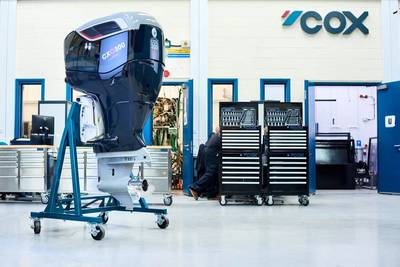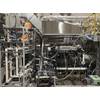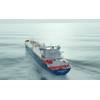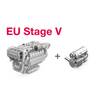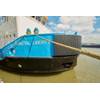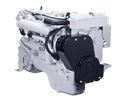Cox Powertrain Leverages the Power of Digitalization
It is not something that pops to mind often: the massive, market-changing advantages of a high-powered, fuel-efficient, cleaner V8 diesel outboard engine. Then, you aren’t a salmon farmer with aquaculture farms in the Norwegian fjords or an islander in the Maldives who drives a Zodiac to work. But, if you are Joel Reid, these are just some of the many things on your mind.
Joel Reid is the Global Sales Director of Cox Powertrain a British start-up based in Shoreham-by-Sea, close to Brighton, UK. A company with a serious desire to change things for the better, Cox knows a business opportunity when it sees one – and knows how to act fast. This was the case with its first product, the CXO300 outboard engine, which is packed with punch yet 25% more fuel efficient and cleaner than most other outboards in the global marine industry.
Specifically designed for the marine industry, the CXO300 is about to go into production. One of the most powerful diesel outboards on the market, this high-performance 300 horsepower engine promises to last three times longer than comparable models. And Cox has more ideas up its sleeve.
“Our CEO Tim Routsis likes to say, ‘We are not developing a product; we are developing a business.’ And this is by far the biggest challenge that we face,” explains Joel Reid, Global Sales Director, Cox Powertrain.
Clearly, Cox didn’t plan to just offer a dedicated marine engine. They also set up a global service network of 200 dealers and representation in 100 countries. And while they reinvented the marine outboard engine, why not reinvent the service model as well? The company aims to redefine the standards of global service and customer care including cloud-based data analytic services, such as engine performance statistics, revenue savings, real-time maintenance information, and other predictive diagnostics.
“We were able to build a much bigger and comprehensive organization to be able to deal with the mammoth task of not just developing a diesel outboard as a product, but also developing an organization that can manage global demand, global services, and volume manufacturing,” adds Reid.
The choice for diesel
In this day and age, the conscious choice for diesel might seem strange to some. But high-performance diesel offers numerous advantages to the marine community. One, it eliminates the burdensome and sometimes messy practice of self-mixing the right gas/oil ratio, a requirement for classic two-stroke outboard engines. Secondly, diesel is cheaper, more readily available, and by far, less combustible than gasoline. And, diesel offers better fuel performance, which means significant bottom line savings for price-sensitive operators with high hour usage ratios. (Think of those aquaculture farmers in Norway or an offshore rig that transports staff back and forth daily.)
“With our engine, you get the fuel savings of an inboard diesel engine combined with the lower risk of an outboard engine. Downtime is a very important aspect for many customers. If they can’t operate, they can’t make money. Diesel engines are dependable workhorses. And, if worse comes to worse, you can swap an outboard engine or transmission. It is much easier to repair than an inboard. This is why our diesel outboard concept is so appealing to broad segment of the market.” Reid adds with a grin, “I can’t see anybody who wants to go fast with a 300-horsepower requirement that wouldn’t want our product.”
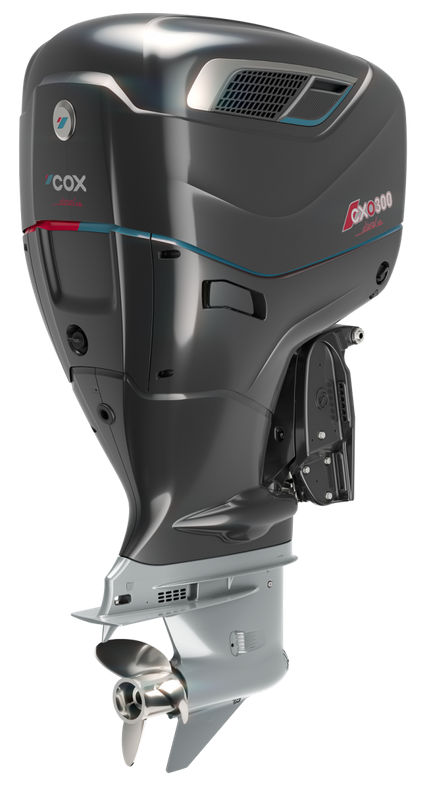 (Image: Cox Powertrain)
(Image: Cox Powertrain)
Designing it right
The bigger commercial picture aside, creating a bespoke, horizontal V8 engine for the marine market requires a high level of excellence when it comes to engineering. And as one would guess, this is something in the heart and soul of Cox. It all started in 2007 when motor-racing engineer David Cox came up with the idea to develop a lightweight diesel outboard using F1 technology. Charles Good joined as Chairman and this idea was extended to the diesel outboard market the next year. When the first concept engine was fired up in 2010, Cox Powertrain was still a very small team of 4 or 5 people. Over the next years, the team worked on the Alpha and Beta engine versions in partnership with Ricardo. In 2014, the current CEO Tim Routsis, a former Cosworth executive and a serious racing insider, joined the company and started to push Cox into the market as a global player.
Over the next five years, engineers and experts from all types of fields from marine and automotive to motorsports and aviation joined the team. Everyone shared a single credo: a passion for fast engines and the belief that Cox could change the marine industry for the better.
Translating this passion and vision into a high-performance reality is, well, a whole different ball game. The team knew the technical challenges were numerous and that getting it right was mission critical.
“We had to make something as small and light as a car engine, but as strong and robust as a big truck engine. Software plays a huge role in understanding how to optimize and design structures. There are so many elements to consider,” explains Reid. “Digitalization for Cox Powertrain is the opportunity to stand out in the crowd.”
Enter the game-changer: Digitalization
And digitalization is where tools from Siemens Digital Industries Software step into the picture. Specifically, the team counts on digitalization tools from the Xcelerator portfolio including Teamcenter for end-to-end integration, NX for seamless design capabilities, and Simcenter for accurate digital twins and performance simulation.
“The Siemens tools are used by a large proportion of our staff. We are also using a Teamcenter integration framework to integrate the Siemens platform into our ERP solution,” explains Tony Ferrier, Head of IT at Cox. “Teamcenter is used by most of our employees. It is at the very core of our business. It holds all our design infrastructure, so it talks to our NX systems. Teamcenter manages all our documentation -- all our bill of materials. This information drives the process all the way from design and engineering to our manufacturing process and production facility.”
Enter the channel partner: OnePLM
But getting the whole process up and running didn’t just happen overnight. Cox counted on Siemens Solution Partner OnePLM, a recognized Smart Expert partner, to help implement the right tools at the right time and to bridge the digital backbone and ecosystem into the company’s ERP and production solutions properly.
“Our IT systems seem quite complex for a small start-up, but as the company grows, it is very scalable. We won’t need to make any major adjustments in our infrastructure. Looking forward, we can go from making tens of engines per week to making thousands of engines per week if required,” adds Ferrier.
The experts from OnePLM are onsite regularly making sure that the Teamcenter, NX and Simcenter installations are up to speed and adapted to the growing infrastructure at Cox.
Stability and Seamless integration:
Teamcenter & NX and the COX design team
Cox is on the fast track when it comes to growth so that means that the software implementation and the design process run in parallel. Luckily, the design team, led by Julian West, is full of experts from F1 racing, motorsports and aerospace. Like everyone at Cox, they are passionate about designing and engineering things that go fast. So, you can imagine that the tools that support this team need to be one step ahead of the game as well. Most of the team has solid NX experience, but, especially on the design side of things, implementing the complete Teamcenter and NX backbone changed the way the team worked.
“We have a large product with 6500-part numbers in the total outboard. For guys working on big sections all day, just letting the tool do its thing, working all day without constantly crashing or freezing with big assemblies open really is one of the most powerful aspects for us,” Julian West, Principal Engineer - Design, at Cox Powertrain.
Another aspect that the design team appreciates is the seamless integration between Teamcenter and NX.
“The best way to explain is that it is practically invisible. The guys in the team fire up their terminals, fire up Teamcenter and fire up NX, open the data they need and get on with it,” adds West.
Julian West was quick to credit the Siemens tools with keeping its bill of materials nice and neat as well.
“For the first time in our business history, we have total control over the total content of our bill of materials. If you have 1000s and 1000s of parts and you are relying on a team of humans to build something, humans are humans, so you will make mistakes. Since turning on all those fancy tools like change control, the vast majority of errors have gone away,” West adds.
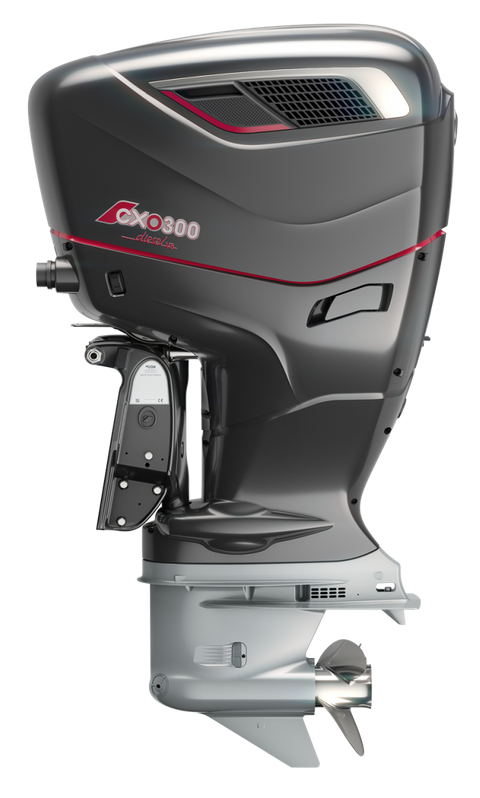 (Image: Cox Powertrain)
(Image: Cox Powertrain)
Confidence in the digital twins
Like many high-end engineering environments, there is an air of friendly competition between the design and engineering teams at Cox. Managed by Euan Freeman, a long-time aficionado of Simcenter Amesim, the advanced engineering team has played a major role in the success of the CXO300.
The art of the possible with a digital twin
Early in the process, the engineering team at Cox started to create a digital twin in Simcenter Amesim. Today, this has advanced to a co-simulation model between the Simcenter Amesim and Simcenter 3D software packages. This advanced engineering model is critical to all kinds of design decisions. Engineers can quickly try out concepts for feasibility studies. They can model parts to see if they are the most effective. They can tweak the model virtually to see how a design change might or might not affect performance criteria. And they can help the test team troubleshoot issues on the prototype. Not to mention, one of its main purposes: advanced performance predications.
“If we can use Simcenter Amesim to simulate something rather than build or 3D model it, we will. It is a flexible tool to turn out quick answers. With Simcenter Amesim, we can potentially get the initial answers in hours or days rather than months,” Euan Freeman, Principal Engineer - Systems Engineering and Fluid Analysis at Cox.
The CXO300 is a massively complicated system and the core job of the engineering team is to balance issues like engine performance, fuel efficiency targets, and emissions. As a start-up, getting that first engine on the market is a question of time as well as money.
“We can take out a huge amount of uncertainty in the first build using Simcenter Amesim. We can do a huge amount of upfront work. We would have 24 variants of engines and have one engine that would have to be built. We are looking at hundreds of thousands of pounds being saved just by doing that upfront. For us, that drives development time down by months and months,” states Freeman.
What next?
As the designers and engineers start work on the next product release and the test team fine-tunes final performance aspects on the water, everyone at Cox is excited to see the first CXO300 outboard roll off the production lines at the new factory in Shoreham-by-Sea.
“We hope that everyone will be fully convinced that high-performance, fuel efficient diesel outboards are the way forward. This is a journey that we all embark on. We are in this for the long run. We are in this to change the market. You do not change the market with a product. You change the market with a commitment, a service that goes for decades and decades…I think that’s what makes us unique,” concludes Reid.
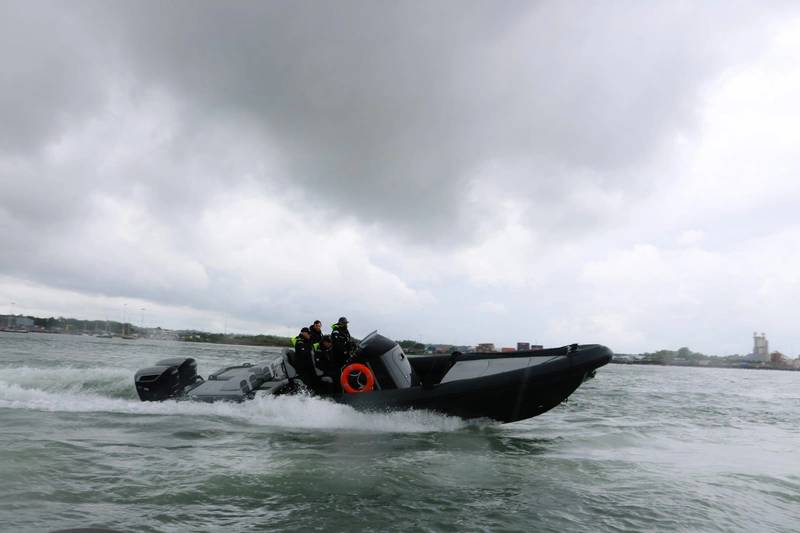 (Photo: Cox Powertrain)
(Photo: Cox Powertrain)


